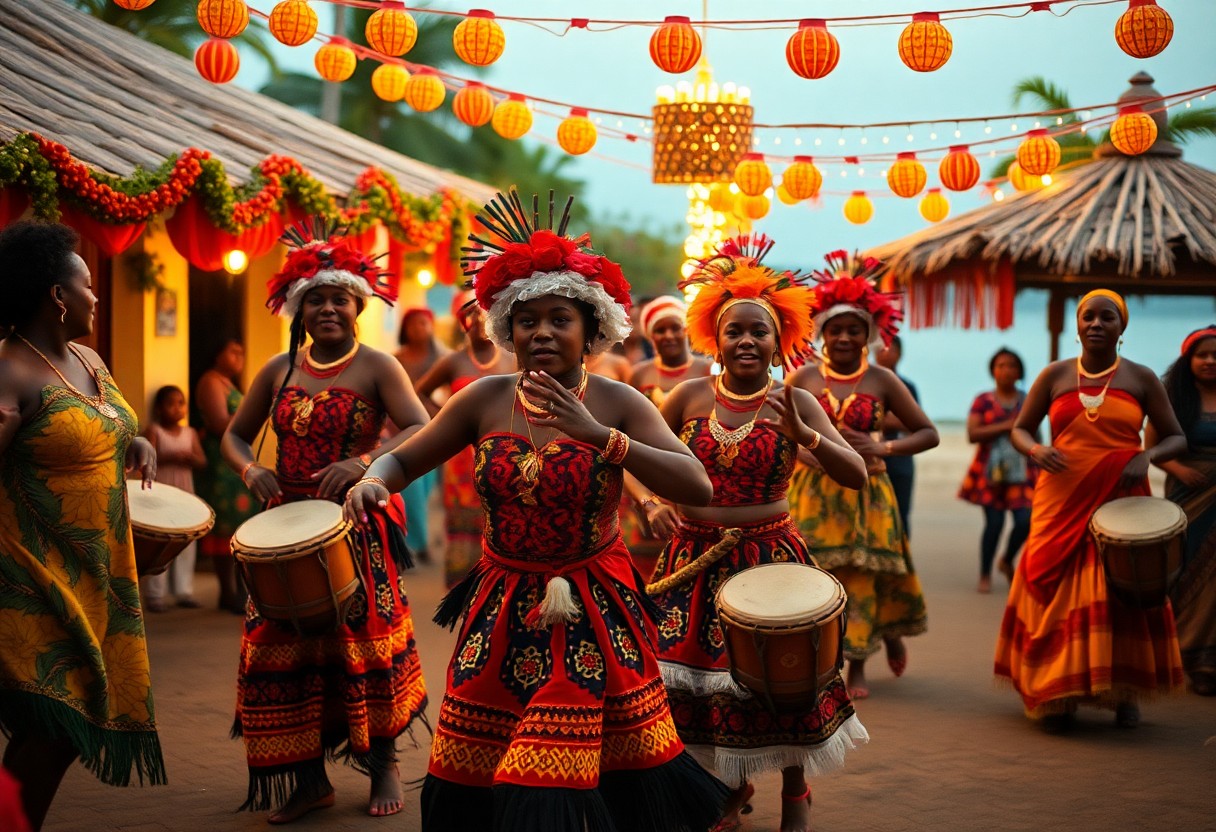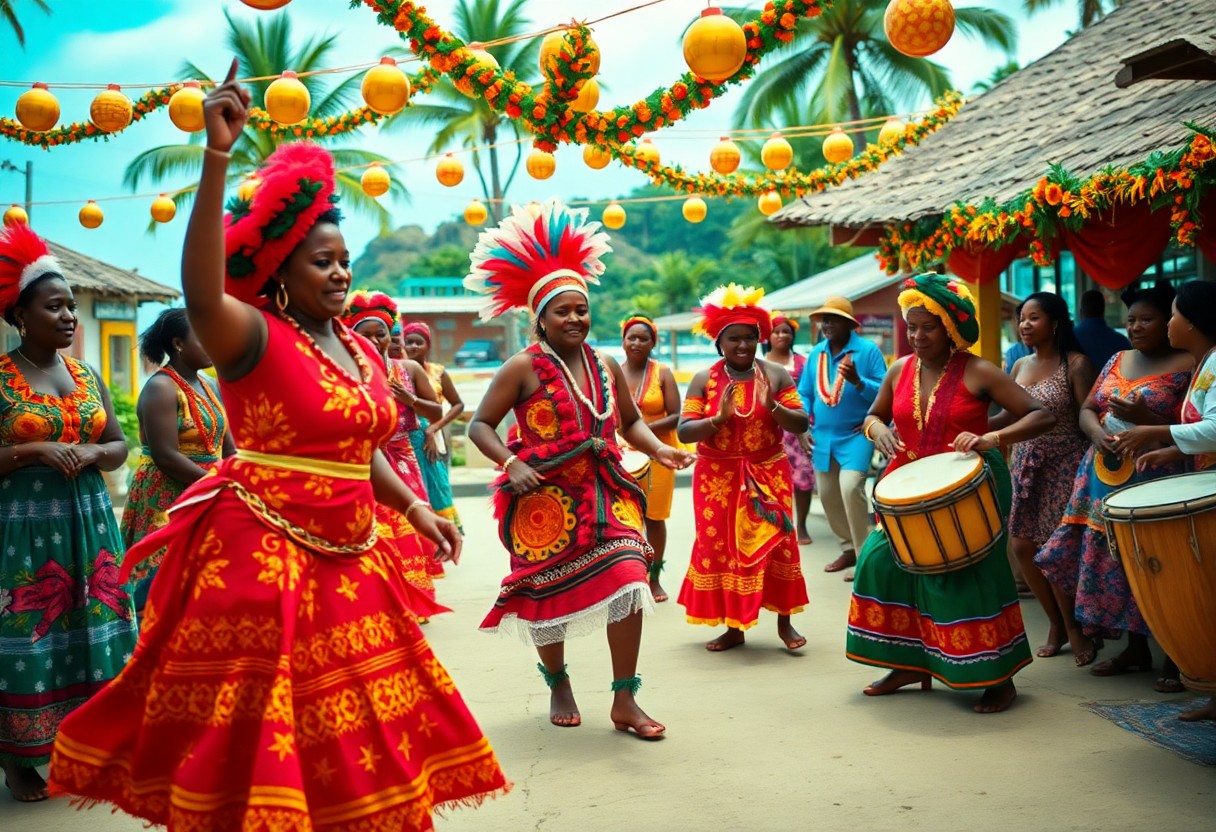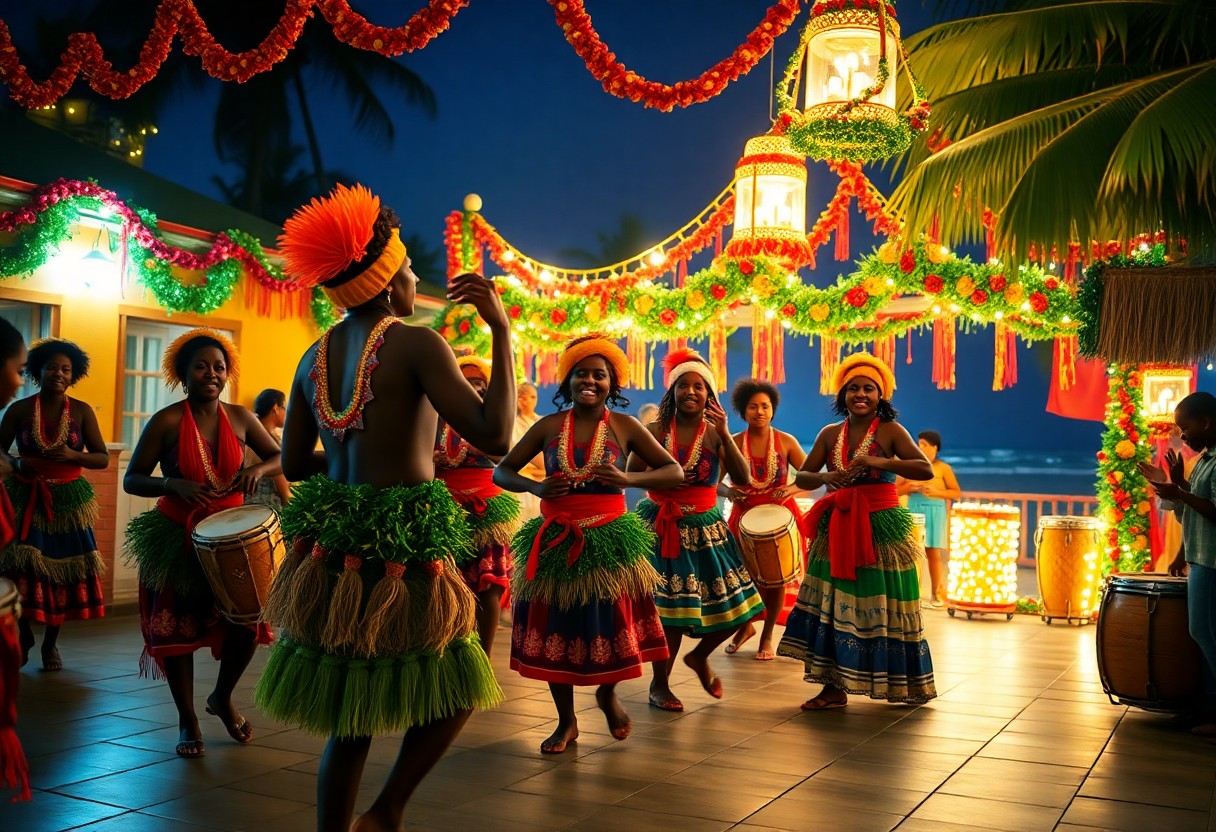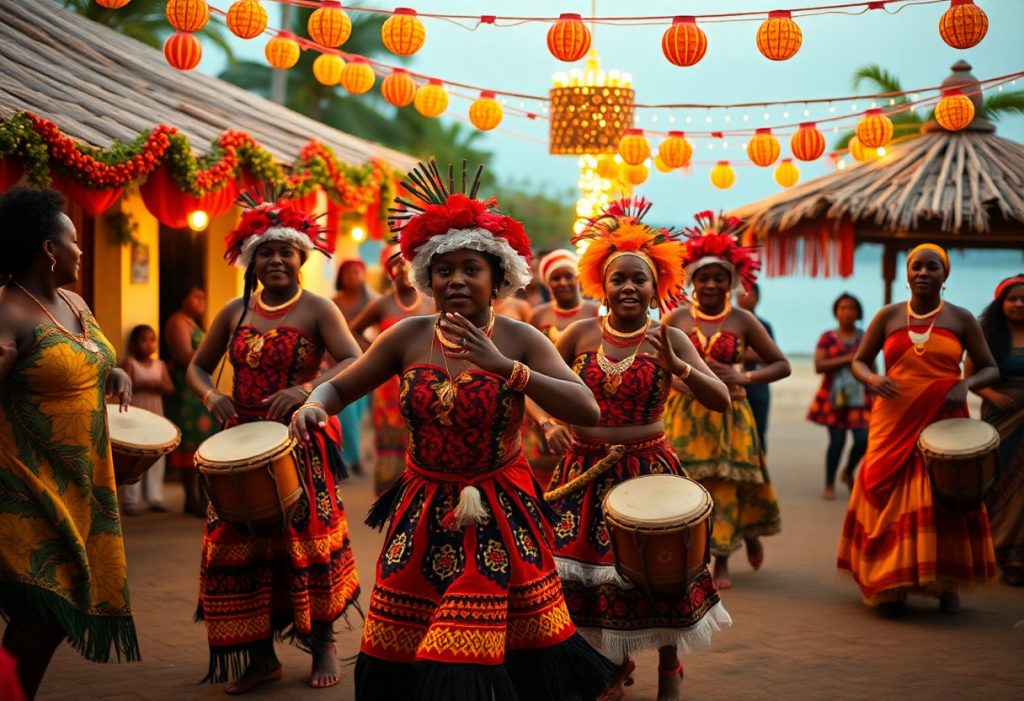Just when you believe you have explored every facet of Christmas traditions, the dynamic Garifuna Wanaragua dance will astonish you with its profound cultural importance. This mesmerizing tradition features dancers donned in pink wire masks and majestic crowns, parading vibrantly through the streets of Southern Belize during the festive season. This cherished practice seamlessly intertwines music, dance, and social commentary, allowing participants and spectators alike to engage deeply with the resilient spirit and artistic creativity of the Garifuna community. Whether you are planning a visit to Belize or looking to expand your knowledge of diverse cultural celebrations, this remarkable blend of historical significance and festive joy will enrich your understanding of Christmas traditions.
Uncover the Rich Cultural Heritage of Wanaragua Dance
As you investigate the complexities of the traditional Garifuna dance, you will discover a distinctive blend of resistance and celebration. This lively dance showcases masked performers, rhythmic movements, and unique costumes that tell stories of cultural perseverance and collective unity. Each dancer plays an essential role in conveying the rich legacy and enduring customs of the Garifuna people, embodying their struggles and victories through the medium of art. By engaging in or observing the Wanaragua dance, you connect with more than just a performance; you become part of a living testament to a culture that has flourished despite adversity.
Examine the Historical Origins and Importance of Wanaragua Dance
Having settled in Belize for over two centuries, the Garifuna people brought forth this significant tradition that has transformed over generations. You can trace the Wanaragua’s roots back to the colonial era, when dancers cleverly employed masks and European-style costumes to satirize their British colonial rulers, effectively turning oppression into an artistic expression of resilience. This extraordinary dance not only conserves historical narratives but also fosters a sense of identity and purpose within the community, serving as a poignant reminder of the power of creativity and performance in overcoming challenges.
Explore the Cultural Importance of Wanaragua Within the Garifuna Community
The Wanaragua dance serves as a cornerstone of Garifuna Christmas festivities, where it strengthens community ties and preserves cultural heritage. In these lively performances, men wear pink wire masks, ornate crowns, and white tops decorated with ribbons, while women participate as Gayusas, providing harmonious vocals that enrich the performance. This communal celebration acts not only as entertainment but also as an essential vehicle for imparting cultural knowledge and values to youth. The dance serves as a living archive, encapsulating the spirit and continuity of Garifuna traditions within Belizean society.
Historical accounts indicate that Wanaragua has evolved into a crucial educational resource for younger generations. Today, participants of all ages, from toddlers to seniors, partake in events such as the Jr. Annual Habinahan Wanaragua Competition, ensuring that this beloved tradition continues to thrive within contemporary Garifuna communities. Each performance serves as a vivid reminder of the significance of cultural heritage and the role dance plays in fostering a unified community identity.
Essential Components That Characterize Wanaragua Dance
To fully appreciate Wanaragua, it is essential to familiarize yourself with its three key components: the masks, costumes, and music. Each of these elements holds profound cultural significance, tracing back two centuries to the arrival of the Garifuna ancestors in Belize. Together, these components weave a rich tapestry that distinguishes Wanaragua from other cultural dances, creating an unforgettable Christmas celebration that resonates deeply with both participants and observers.
Investigate the Traditional Costumes and Masks Used in Wanaragua
To fully experience Wanaragua, you will see dancers adorned in pink-painted wire masks showcasing European features. Their costumes comprise white shirts embellished with vibrant ribbons across the chest and waist, complemented by cowry shell knee pads that enhance the rhythmic sounds of the dance. Your attention will be captivated by the magnificent crowns crafted from crepe paper, mirrors, and feathers, symbolizing a powerful act of cultural pride and resistance. Each element of the costume is thoughtfully designed to not only enhance visual appeal but also convey the rich history and significance of Garifuna culture.
Discover the Unique Musical Elements and Rhythms of Wanaragua
The rhythms of Wanaragua follow a distinct structure, primarily led by two essential drums: the primero and segundo. You will be entranced by the intricate combination of drumbeats and the rattling of cowry shell knee pads, creating a captivating musical experience that drives the dancers’ movements. These rhythms serve not merely as background music; they are the lifeblood of the performance, dictating the pace and emotional expression embedded in each dance step.
Instruments central to your Wanaragua experience include the traditional Garifuna drums, crafted from hollowed-out tree trunks and animal skins. The female singers, known as Gayusas, contribute their voices to the ensemble, forming a powerful amalgamation of percussion and vocal harmony that has been cherished and preserved over generations. This musical interplay is vital to the dance, enhancing the overall experience and connecting performers and audiences through the universal language of rhythm.

Explore the Diverse Types of Wanaragua Performances Available
You can fully immerse yourself in Wanaragua dance performances through two distinct formats, each offering unique opportunities to engage with Garifuna culture. These performances vary from traditional house visits to modern festival showcases, each presenting its own flavor and community relevance.
| Performance Type | Characteristics |
|---|---|
| House-to-House | Traditional, intimate, community-focused |
| Festival Shows | Large-scale, choreographed, competitive |
| Time Duration | 15-30 minutes per performance |
| Participant Number | 3-10 dancers per group |
| Musical Elements | Drums, vocals, shell rattles |
Engage with the Traditional House-to-House Dance Experience
During the Christmas season, Wanaragua dancers bring the festivities directly to your doorstep. You’ll witness performers elegantly moving through neighborhoods, pausing at homes where families gather on porches. This intimate performance style fosters personal connections between dancers and audiences, creating a shared experience that strengthens community bonds and emphasizes the significance of local traditions.
Immerse Yourself in Contemporary Festival Presentations of Wanaragua
Clearly, you can see how Wanaragua has transformed through organized festivals and competitions. These events not only showcase local talents but also play a crucial role in preserving cultural heritage through structured performances. Attending these festivals provides you the opportunity to witness competitive showcases where dancers demonstrate their skills at events like the Battle of the Drums and Jr. Annual Habinahan Wanaragua Competition. Your participation, whether as an audience member or performer, is vital in ensuring this valuable tradition thrives for future generations.
Learn the Dance Steps: Your Complete Guide to Wanaragua
While it may appear intricate, mastering the Wanaragua dance can be accomplished through perseverance and a solid understanding of its essential components. Your journey begins with learning the basic footwork and gradually advances to more complex movements that define this traditional Garifuna dance. Each step you master will draw you closer to capturing the vibrant essence of this cultural expression.
Basic Dance Elements
| Footwork | Three-step pattern, heel-to-toe movement |
| Body Position | Upright posture, shoulders squared |
Master the Fundamental Movement Patterns in Wanaragua
One of your initial tasks in learning Wanaragua involves mastering the foundational three-step pattern. Your feet should move in a rhythmic sequence that aligns with the drumbeat while maintaining balance against the shell-adorned knee pads. This foundational movement is crucial, as it lays the groundwork for more intricate choreography that you will learn in subsequent stages.
Enhance Your Skills with Advanced Choreography Techniques
- Mask manipulation techniques
- Synchronized drum responses
- Directional changes
- Group formation movements
To excel as an advanced Wanaragua dancer, you must master the precise timing between movements and drum beats. Your performance should showcase seamless transitions and confident handling of masks, allowing you to convey the spirit of the dance effectively.
Advanced Techniques
| Mask Work | Side-to-side movements, circular motions |
| Rhythm Response | Quick tempo changes, syncopated steps |
Comprehending the cultural significance of each movement will greatly enhance your performance. Your advanced routine should seamlessly integrate traditional elements while preserving the satirical essence of the Wanaragua dance, offering audiences a captivating experience that resonates on multiple levels.

Essential Strategies for Excelling in Wanaragua Performances
To thrive in the Wanaragua dance, it’s vital to focus on three primary aspects: rhythm, footwork, and mask control. Achieving proficiency in these areas will elevate your performance and deepen your connection to the dance.
- Maintain an upright posture to ensure balance and poise
- Synchronize your steps with the drum beats for fluid movement
- Practice mask balance while performing various movements
- Keep consistent energy throughout your performance to captivate the audience
If any mistakes occur during your performance, a swift spin or knee dip can effectively camouflage the error, allowing you to maintain the dance’s momentum.
Costume Preparation Tips for Wanaragua Dancers
Your Wanaragua costume requires meticulous attention to detail. Secure your mask properly, arrange your ribbons with care, and test your cowry shell knee pads prior to the performance. Ensure your crown is well-balanced and adorned with vibrant colors that complement your outfit, as these visual components significantly impact the overall effectiveness of your performance.
Practice Recommendations for Aspiring Wanaragua Dancers
Rehearsals focused on costume adjustments are vital for you to acclimate to the weight and movement constraints of your Wanaragua outfit. Practicing for at least 2-3 hours each week will enhance your stamina and help you refine your movements. Your footwork must align perfectly with the drum rhythms to create a cohesive performance.
Preparation requires your full commitment to mastering the traditional steps. Start with basic movements without the mask and progressively incorporate costume elements to ensure comfort. Your practice sessions should include drum accompaniment to improve your timing and rhythm awareness. Regular feedback from experienced dancers will also enhance your performance quality and deepen your connection to the dance.

Critical Factors Impacting the Preservation of Wanaragua Dance
The survival of the Wanaragua dance tradition depends on several key elements that interact within today’s changing society. You will observe that cultural education, community support, and local festivals play crucial roles in sustaining this heritage. The future of this tradition hinges significantly on:
- Active youth involvement in cultural events
- Regular organization of cultural celebrations
- Family participation in teaching and performing
- Efforts to document history and practices
The interplay of these factors guarantees that Wanaragua remains a vital aspect of modern Garifuna culture, promoting appreciation and understanding among future generations.
The Role of Community Engagement in Preserving Wanaragua Dance
The success of preserving Wanaragua relies deeply on your community’s active involvement. You’ll notice local organizations hosting weekly practice sessions and cultural centers providing venues for performances. Engaging in these activities not only sustains the vitality of this tradition but also reinforces community bonds and nurtures a collective sense of identity.
Ensuring Knowledge Transfer Across Generations in Wanaragua
The effective transfer of Wanaragua knowledge necessitates a dedicated effort from older generations to the younger ones. You’ll find elders teaching specific dance moves, mask-making techniques, and the deeper meanings behind each performance component. This transmission of knowledge is vital to keeping the tradition alive.
To facilitate effective knowledge transfer, you need to implement a structured learning approach. Children can start learning basic steps as early as five years old, progressively advancing to more complex movements as they mature. Experienced dancers typically dedicate 20-30 hours monthly to instructing younger performers, ensuring the tradition continues to thrive through successive generations.
Experience the Vibrant Essence of Wanaragua Dance
With this understanding, you can appreciate how Wanaragua serves as a vibrant symbol of Garifuna heritage and resilience. Your exploration of this Christmas tradition reveals how the dance interweaves colorful masks, dynamic movements, and rich symbolism to narrate the story of a resilient culture. Witnessing the dancers as they move to the drum beats, adorned in their wire masks and elaborate costumes, will provide you with insight into why this tradition has persisted for over 200 years. Your engagement with Wanaragua links you to a living expression of Belizean cultural history that continues to flourish and adapt with each generation.
Common Questions About Wanaragua Dance
What is the traditional attire for Wanaragua dancers?
Wanaragua dancers typically wear white tops embellished with vibrant ribbons across the chest and waist. They don wire masks painted pink with European features, crowned with adornments made of crepe paper, mirrors, patterned fabric, and feathers. The ensemble is completed with cowry shell knee pads that create rhythmic sounds during the dance, contributing to the overall auditory experience.
When and where can you see the Wanaragua dance performed?
The Wanaragua dance is showcased during the Christmas season in Southern Belize, typically following Garifuna Settlement Day in November. Dancers traverse neighborhoods from house to house, with families observing from their porches or yards during evening festivities, creating a communal atmosphere of joy and cultural celebration.
Who performs the Wanaragua dance and what are their roles?
In traditional performances, men take on the role of primary dancers in Wanaragua, while women act as Gayusas, contributing their voices alongside the drummers who play the primero and segundo drums. Today, dancers of all ages participate, from young children to seniors, aiding in preserving this rich cultural heritage.
The Article Wanaragua: Celebrating the Garifuna Christmas Dance Tradition appeared first on Belize Travel Guide
The Article Wanaragua: Embracing the Garifuna Christmas Dance Tradition Was Found On https://limitsofstrategy.com



The Garifuna Wanaragua dance truly is a fascinating lens through which to view the intertwined nature of cultural identity and tradition, especially during the festive Christmas season. It resonates with me deeply as it highlights the importance of storytelling in the preservation of culture. I was recently reflecting on how, in many indigenous and marginalized communities, art forms such as dance provide not just entertainment, but also a means of resistance and a way to assert cultural pride.
You make an excellent point about the significance of storytelling in cultural preservation. The Garifuna Wanaragua dance does so much more than entertain; it carries the weight of history, memory, and identity. When you think about it, each movement in that dance conveys layers of meaning tied to the community’s struggles and triumphs.
You bring up such an important aspect of how dance acts as a vessel for heritage and collective memory. The Garifuna Wanaragua really exemplifies how art forms can serve not just as entertainment but as a bridge to understanding a community’s deeper narrative. Each intricate movement speaks volumes about resilience and the richness of cultural identity, doesn’t it?
While the Wanaragua dance is indeed a fascinating facet of Garifuna culture, I can’t help but wonder about the broader social implications surrounding its performance today. For many communities like the Garifuna, traditions like this represent more than just celebration—they often serve as acts of cultural resilience, especially in the face of globalization and cultural erosion. It might be worthwhile to explore how contemporary challenges, such as climate change and displacement, influence these traditions. Are younger generations in Belize as engaged with the Wanaragua dance, or do they seek new forms of expression? This intersection of tradition and modernity could offer rich ground for further dialogue, perhaps shedding light on how cultural practices evolve while remaining rooted in their historical significance.
You raise some really important points about the Wanaragua dance and its broader significance. The idea of cultural resilience is central to understanding how traditions like this can adapt and thrive amid challenges like globalization and climate change. Many Garifuna communities are actively engaging with these issues, using the dance not just as a form of artistic expression, but also as a way to reclaim and maintain their identity.
The Wanaragua dance truly embodies the resilience and creativity of the Garifuna community, and it’s fascinating how this tradition serves as both a celebration and a form of social commentary. It reminds me of how dance in various cultures often acts as a storytelling medium—bringing historical struggles and triumphs to life while fostering a sense of community.
Reading about the Garifuna Wanaragua dance really brings a whole new perspective on how Christmas traditions can vary around the world. I hadn’t heard of the Wanaragua dance before, and it’s fascinating to learn about its role in celebrating not just the festive season but also the cultural richness of the Garifuna community.